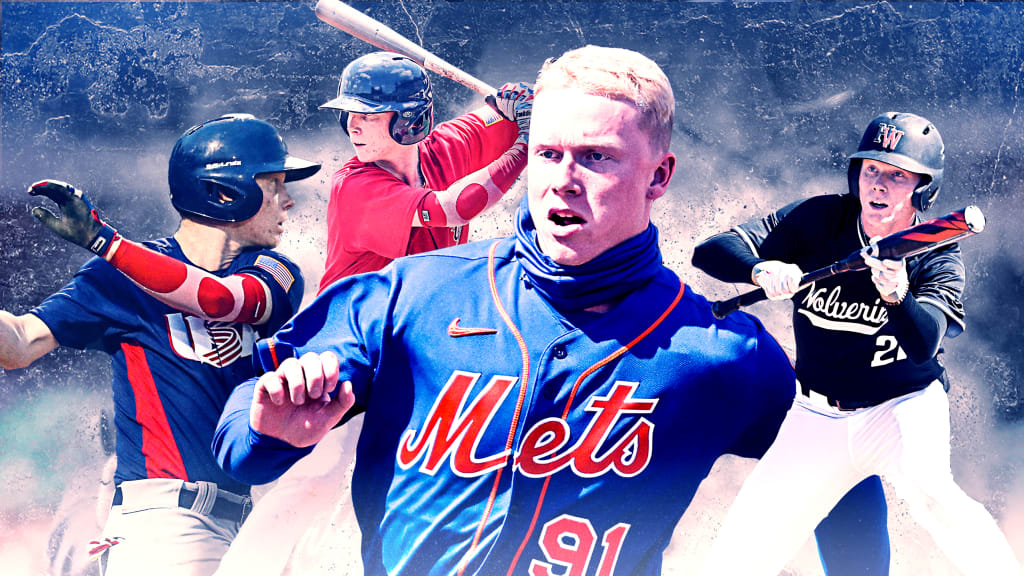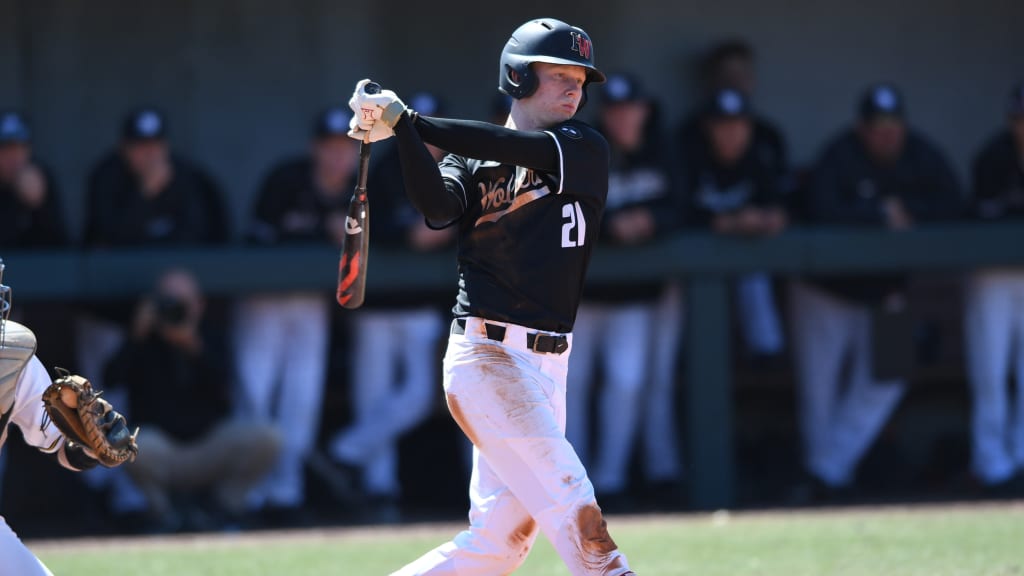
Spring break has become synonymous with partying, beaches and fun for America's college-aged populations. For Pete Crow-Armstrong, the first of what he hopes is many annual trips to Florida is quite different.
While the young outfielder is spending his spring in the Sunshine State, the similarities with spring breakers ends there. There are no late nights partying or sunbathing on the beach. Instead, the Mets' 2020 first-round Draft pick was rubbing elbows with Major Leaguers during his first Spring Training in Port St. Lucie.
A teenager participating in spring workouts isn't unique, but Crow-Armstrong's case is a bit different. Such is life in a pandemic-plagued world that wiped out the 2020 Minor League season and with it, the opportunity for the Mets' No. 5 prospect to make his professional debut. Instead, Crow-Armstrong earned a non-roster invite to Spring Training where he found himself alongside All-Stars Jacob deGrom, Pete Alonso and Francisco Lindor. All before ever seeing a single pitch as pro.
"It was completely unexpected to get an invitation [to big league camp]," Crow-Armstrong said. "I didn't have any expectation of being here and I'm grateful to the Mets for giving me the opportunity. I'm here to learn as much as I can each day. It's a great opportunity for someone in my position."
The Sherman Oaks, Calif. native arrived in Florida in early February and quickly found his way into a Grapefruit League game March 2. Crow-Armstrong struck out in his lone plate appearance against the Astros, putting him among a rare class of prospects who played in a Major League game before setting foot in the Minors ... even if it was an exhibition. He notched his first -- and so far only -- hit of the spring four days later, lacing a triple to right field.
"I didn't think I'd be playing games this soon," Crow-Armstrong said." The first few games were surreal. It was my first time on a big league field in a big league uniform. Sitting there in the dugout and looking at Major Leaguers is an unbelievable feeling. I'm using it to my advantage ... seeing how they react to things and asking as many questions as I can. I love the atmosphere and the interaction. It's great."
Conversely, the club loves what they see from their first rounder, who came to the club with an IQ that match his talents on the field. Crow-Armstrong may be a professional with sky-is-the-limit potential, but he'll play this season at 19 years old while sporting a maturity level far beyond that. He credits his parents and a culture at Harvard-Westlake School, a college preparatory institution in Los Angeles.
Well regarded for its academic standing, the school has also become a baseball hotbed in recent years. Including Crow-Armstrong, Harvard-Westlake has produced four first-round Draft picks since 2012, including Lucas Giolito, Max Fried and Jack Flaherty, who played together.
"As an institution, we pride ourselves on developing kids for a future in all walks of life," said Jared Halpert, the head of Harvard-Westlake's baseball program. "Pete's very mature and wise beyond his years and it helps him off the field as much as on it. He's just an amazing competitor and his motivation, commitment and a work ethic is a source of pride for him. Pete's a winner at heart and took on a coaching-type role with us to keep not only himself but his teammates accountable."
It was another sizable piece of the puzzle that drew hordes of scouts to Harvard-Westlake games. Unsurprisingly, Mets vice president of amateur and international scouting Tommy Tanous was among them.
"We knew his ability coming in, but I'm most pleased with the poise he's shown," Tanous said. "Our staff works hard to find out as much as we can about our Draft picks. We brought them in, talked to them and I believe we did a very good job of finding players who understand what it takes to play professional baseball. But it goes deeper than just success on the field.
"Pete was one of the best players on every team he played for. He competed on a high-powered high school club and played with Team USA. The skills were obvious, but our scouts always came away raving about his IQ and maturity, especially for a teenager."
That talent didn't completely manifest itself on the field until Crow-Armstrong became a teenager. An athlete who competed in all sports -- he was especially fond of soccer and basketball -- baseball officially took hold when he began playing with the 12U Team USA National Team in 2014.
"It was definitely a 'coming out' party," Crow-Armstrong said of his national competition. "That's when I started to think, 'Hey, I'm a pretty good player. Maybe I can do something with this.' I began to realize I could hang with some of the better players from outside my local area. It spurred me to keep pushing and learning, but I never thought I was the best or better than anyone else."
Competing with Team USA became an annual affair for Crow-Armstrong. He played with the 15U and 18U National Teams and again in 2019 when he batted .364/.405/.606 with seven extra-base hits and four stolen bases in nine games. He also flashed his 65-grade defense, robbing a pair of home runs against Chinese Taipei and Australia. Crow-Armstrong was named the World Cup's All-World Center Fielder for his efforts.
Although COVID-19 limited his 2020 high-school season to just 10 games, Crow-Armstrong had a commitment to attend Vanderbilt in his pocket if he decided to spurn the opportunity to turn pro. The Mets came calling with the 19th overall pick last June and he quickly made up his mind.
"A lot of people zeroed in on Pete," Tanous said. "He had that type of talent and pedigree. He was our style of player and someone we wanted. He controls the strike zone, plays defense and is a high-IQ player. He checked a lot of our boxes and sat atop our list."
Crow-Armstrong's status wasn't a surprise. MLB Pipeline ranked him its 20th-best prospect entering the Draft and Halpert knew his former protégé was on his way.
"You never know how a kid will develop, but Pete made a name for himself as a 12-year-old [with Team USA]," Halpert said. "Now, there is a very big difference between high school and 12U, but the talent was real. Would he progress and turn into one of the best players in the country? Obviously, he did."
Crow-Armstrong's selection in the first round of the Draft was tempered somewhat by COVID-19. Not being able to make his professional debut left traces of disappointment, but as is his wont, he put it into perspective.
"Of course, I wanted to get out there and play," he said. "But the disappointment wasn't so much for me but with everything that was happening in the world. People were and still are dying from a raging pandemic. I took a step back and realized how fortunate I was. I still worked out and got all of my work in. In a way I think waiting is almost a blessing. I was able to develop a routine and find some good out of an otherwise terrible situation we all find ourselves in."
In a period where everyone needed to adjust on the fly, Tanous admits the challenges scouts and player development folks encountered were problematic. But like everything else, they made do with what they were given.
"[Minor Leaguers] had it really tough in 2020, especially the kids just drafted. Although we were in constant communication throughout the summer and offseason, it had been a long while since we had actually seen them on the field. There's always a bit of an unknown when there is that much time away from competitive games. Nothing replaces being on the field and seeing guys compete."

Tanous also noted the organization is looking far beyond Crow-Armstrong's numbers in 2021. In reality, at this point in time, they're not terribly important.
"We're not focused much on Pete's statistics this year. We want to see how he's adjusting to the grind of playing every day, being away from home and the routine he's built for himself. At this stage, hitting .250 or .310 is not a point of emphasis. Obviously we want to see him succeed and be competitive, but we also need to see his flaws and witness his failures. Those things inevitably show up in the transition to professional ball."
Hearing those remarks elicited a small laugh from Crow-Armstrong, who all but repeated Tanous' comments when asked about his own expectations for the upcoming campaign.
"No one wants to have a bad year statistically," he said. "But I don't have any expectations right now. I'm focused on my daily work and what I'm doing here in Spring Training. Right now is about getting better and learning. That is my focus and that's what I want to do. I know I'm going to play in the Minors this year. I'm not fighting for a job to stay in baseball. It's my first year and I just want to go out, have fun and continue to learn."
A large part of those daily experiences has involved getting to know the faces of the organization but also learning from the guys who have already made their mark.
"People have been the best part of this experience so far," Crow-Armstrong said. "From the guys who are trying to earn a spot on the roster to established players like Michael Conforto and Brandon Nimmo, everyone has the same goal here. The organization has embraced the chance to win, and no matter who you are or where you're playing this year, you feel as if you're a part of that journey.
"As a teenager, that's extremely special to me and something I'd never thought I'd be able to enjoy at this stage. I feel so lucky to be out here."


